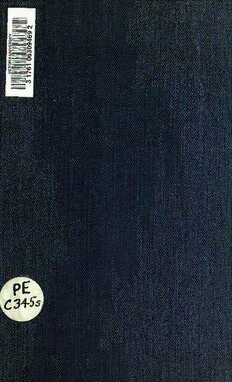
H. Munro Chadwick - Studies in Old English PDF
Preview H. Munro Chadwick - Studies in Old English
^^ ^^ PE STUDIES IN OLD ENGLISH BY H. M. CHADWICK. Q A PREFATORY NOTE. THE following essays make no claim to supply the long-felt want of a grammar of Sweet's Oldest English Texts. They are concerned with the investigation of cer- tain problems in Old English phonology, with a view to ascertaining the distinctive characteristics of the Old English dialects and the chronological sequence of the sound-changes which marked the early history of the language. It ought to be explained that these essays were com- pleted in April of last year, several months before I was able to see the third edition of Sievers' Angelsdchsische Grammatik. Consequently the references are to the second edition (Cook's Translation) throughout. I have called at- tention, however, in the footnotes to many of the changes introduced in the third edition, and I hope that I have not passed over anything of importance bearing on the problems here discussed. It will be found that several of the theories, against which I have contended in the earlier chapters of this paper, have been in part modified or with- drawn in the third edition; in one or two cases, indeed, the new explanation is practically identical with that which I have proposed. After some hesitation I decided to let my work remain in its original form, because Sievers' book, while stating conclusions, does not profess to give a detailed account of the processes by which these conclusions have been attained. 72 88 PREFATORY NOTE. [iv A word of apology is needed in regard to the nomen- clature employed in the designation of the hypothetical texts discussed on p. 96 ff. This might certainly have been improved, but unfortunately it was brought to my notice too late to admit of any alteration being made. I cannot let this opportunity pass by without testifying to the value of the services rendered to the cause of English Philology by the publication of The Oldest English Texts. Without that work any such investigation as the present would of course have been impossible the labours of the ; investigator also have been materiallylightened bythe accu- racy and the very convenient arrangement of the glossary. In conclusion my thanks are due to the Cambridge Philological Society for allowing this paper to be pub- lished in their Transactions, and especially to the Presi- dent, Prof. Ridgeway, for the kindly interest he has throughout taken in the work. Above all I have to thank Prof. Skeat, who has gone through both the manuscript and the proofs, and to whom I am indebted for many valuable suggestions. H. M. CHADWICK. CLARE COLLEGE, May, 1899. CONTENTS. PAGE 1. Introduction 93 2. The History of the Older Diphthong.s: .. .. .. .. 95 i. The {-umlaut of diphthongs..... 95 ii. Palatal umlaut 99 iii. The loss of intervocalic -h- 105 Note 1. The chronology of the changes i iii . 115 Note 2. ThehistoryoftheGermanicdiphthongan 118 3. The Diphthongs arising from Germ, a, e, i before r, I fol- lowed by a consonant . .... .. .. .. .. 121 4. The Treatment of Germanic -w- 129 5. The Loss of Intervocalic -j- 146 6. The History of the diphthong in freo etc. . . . 148 7. The Verb W.Sax. Vreag(e)an, Ps. iSregan . . . 150 8. The Treatment of Germ, -a- before Nasals . . . 151 9. The Change of a > sel .... 153 10. The Syncope of -u after a long syllable 156 11. The Gemination of consonants before -j- . . . 159 12. The Phonetic Value of -g- 170 13. Dialectic peculiarities: 175 i. Northumbrian 176 n. The dialect of the Psalter 180 in. Kentish 182 14. The Epinal, Erfurt and Corpus Glossaries : . . . 188 i. &l 190 ii. e2 196 iii. a before +consonant . . . . . . 199 iv. 2 199 v. Q 200 vi. a;5 204 vii. ' 206 90 CONTENTS. [vi PAGE viii. He2 210 ix. The m-diphthongs 212 x. #3 213 xi. 3 214 xii. The diphthongs eo and lu (/.) .. .. .. .. 216 xiii. Palatal umlaut 218 ..... xiv. Labial and back umlaut 226 xv. Palatal diphthongisation 228 xvi. The loss of interior -h- 229 xvii. The representation of medial and final Germ. /. 232 xviii. The representation of medial and final Germ. # 233 ...... Note. Forms in which the etymological value of /, b is uncertain 238 xix. The orthography of the.Glos.sari.es .. .... 241 xx. The comparative faithfulness of the three texts . 245 xxi. The age of the texts 246 xxii. The dialects 249 15. Chronology of the Earlier Dialectical Variations . . 253 16. Chronology of the Earliest English Sound-changes. . 256 17. The position of English among the Germanic Languages 259 NOTE. The references in Bede are to Plummer's Baedae Opera Historica. It is to be observed that B = Cotton Tiberius A xiv, C=Cotton Tiberius C n. "The Alphabet" refers to the names ofthe Runic letters given in Cod. Sal. 140 (quoted from Wimmer, die Runen- sckrift2, p. 85). The NorthumbrianRunic inscriptions are quoted from Victor, die northumbrischen Runemteine. In every other case the reference is to Sweet's Oldest English Texts. West Saxon forms are usuallyquotedfrom Cosijn's Altwestsdchsische Grammatik. It should be observed that C=the Cottonian MS., H=the Hatton MS. ofthe Cura Pastoralis (C.P.). The grammars containedinBraune'sSammlungkurzerGrammatiken gennanischer DialeJcte are quoted under the names of their respective authors. The same plan has been occasionally adopted in the case of gZreaumnmeart=icZaelunetrre'astiSspersawchhiecdhesdekaelntwiistchhenspPescailatlerdsi,alLeicntdseloorf=texLtisnd:eltohfu'ss Sprache des Ritualsvon Durham. Amongst other abbreviations the following may be noted : = O.E. 01d English. = O.H.G. 01d High German. M.L.G.=Middle Low German.
